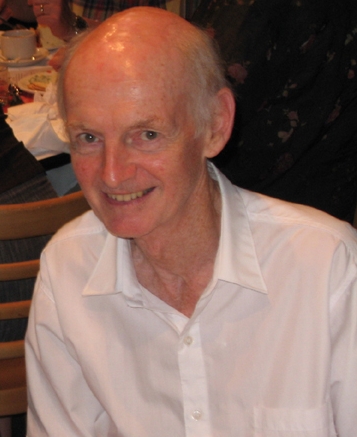 Jim Caswell at a maser meeting in Alice Springs, 2007. (Photo courtesy of Miller Goss)
Jim Caswell at a maser meeting in Alice Springs, 2007. (Photo courtesy of Miller Goss)
James L. Caswell
Contributed by Simon Johnston and Jessica Chapman
James (Jim) Leslie Caswell was born in England in 1940 and after completing high school in Thornbury went to St John's College, Cambridge where he obtained his undergraduate degree in 1962. He subsequently joined the radiophysics group of Prof Sir Martin Ryle at the Cavendish Lab in Cambridge where he was awarded his PhD in 1967 for Astronomy studies using a large-aperture synthesis radio telescope operating at 178 MHz.
He was awarded a Canadian Research Council fellowship and took up at post doctoral fellowship at the Dominion Radio Astrophysical Observatory (DRAO) in Penticton, Canada from 1967 to 1969. He subsequently moved to Sydney and started at the (then) CSIRO Division of Radiophysics (now CSIRO Astronomy and Space Science) on 6 January 1970.
Jim remained at the CSIRO, apart from a sabbatical back in Cambridge, UK in 1976 and a two year sabbatical at the DRAO, Penticton in 1983/84. Although Jim retired several years ago he continued his highly productive research career at CSIRO right up to his admission in hospital shortly before he died.
Jim had more than 200 papers in the refereed literature dating back to his first paper (published in Nature!) in 1965. His two most highly cited papers are well known to all Galactic astronomers. Clark & Caswell (1976) used Molonglo and Parkes observations to map and study the properties of southern Supernova Remnants, including a derivation of their distances, and Caswell & Haynes (1987) lists properties of over 300 Galactic HII regions and is a handbook for anyone interested in Galactic structure.
Jim made significant contributions to the Australia Telescope National Facility including during the construction of the Compact Array (ATCA) and recently as Project Scientist for the Compact Array Broadband upgrade on the ATCA. Jim's scientific passion was masers and Galactic structure and indeed some 90 of his papers have "maser" in the title. Most recently, he was a leader of the Parkes Methanol Multibeam (MMB) survey and subsequent follow up with ATCA, which discovered hundreds of methanol masers associated with high-mass star forming regions. The sequence of papers arising from the MMB are typical of Jim's output defined by scientific excellence, integrity, attention to detail and not a comma out of place or dangling participle to be seen!
Jim was, at his core, a research scientist whose passion was solving problems and understanding the Universe. He was always a loyal and kind-hearted colleague, encouraging to others and a patient teacher and mentor. Away from his science, Jim was a long time member of ATNF's social tennis and ping-pong groups.
Jim died on 14 January 2015.
![[IAU logo]](iau_wb_thumb.jpg)
![[URSI logo]](URSI-logo-thumb.jpg)
![[Karl Jansky at his antenna]](jansky_photo_02_thumb.jpg)
![[Reber's Wheaton antenna]](Reber_Telescope_Wheaton_thumb.jpg)
![[Dover Heights]](Dover_Heights_02_thumb.jpg)
![[4C telescope]](GB61-195_4C_telescope_thumb.jpg)
![[Ewen and horn antenna]](ewen_horn1s.jpg)
![[Dwingeloo, 1956]](Dwingeloo-1956-thumb.jpg)
![[Jocelyn Bell Burnell and Cambridge antenna used in pulsar discovery]](burnell2_thumb.jpg)
![[Lovell Telescope at Jodrell Bank]](site_1594_0001-500-334-20180316163019-thumb150.jpg)
![[Wilson, Penzias, and Bell Labs horn antenna]](wilson-penzias-horn_thumb.jpg)
![[6-m Millimeter Radio Telescope in Mitaka, Japan]](6m-thumb.jpg)

